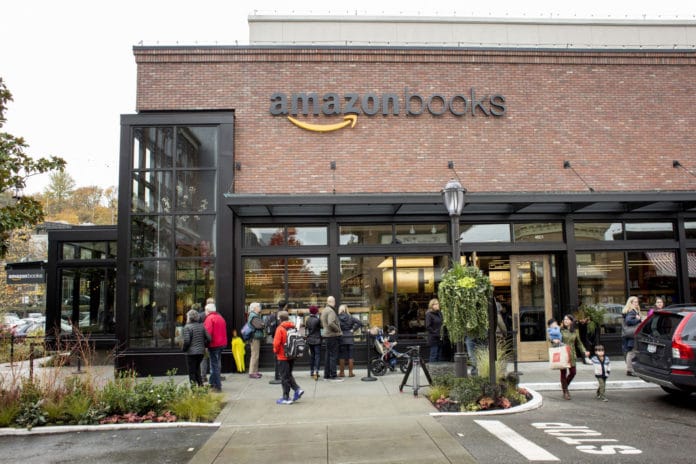Amazon’s plans to open as many as 400 brick- and-mortar bookstores, revealed Tuesday by a mall executive, may seem an unlikely turn of events. But should Amazon proceed, it will have plenty of company.
In recent years, a rash of e-tailers from Warby Parker to Bonobos have opened stores. Some are popups, but others are designed to be permanent. Three key forces are driving this trend. Malls, keen to find new tenants as struggling traditional retailers close stores, see online merchants as potential traffic drivers. E-tailers have discovered that a physical location helps consumers discover their brand. Traditional retailers, meanwhile, are buying or partnering with online merchants and opening boutiques inside their stores.
“All these slick e-commerce startups have realized, ‘What a great way to get customers,'” said Howard Tubin, a New York- based retail analyst. “Open a store, let people touch and feel and try on your product, and then convert them to e-commerce.”
Bonobos, an online purveyor of menswear, is in all Nordstrom locations and has opened 20 standalone stores around the United States. The relationship with Nordstrom cuts both ways. Bonobos can reach older customers and women shopping for men. Nordstrom pulls in younger shoppers who know Bonobos.
“Thousands and thousands of customers have discovered us through Nordstrom,” said Bonobos Chief Executive Officer Andy Dunn. “It’s been a huge stage in the brand evolution. We view it as a way to reach a much more diverse audience much more quickly.”
Last summer Birchbox, an online cosmetics seller, opened seven popups in Gap stores across the United States. Again, both companies stand to benefit from the experiment. Gap was “interested in seeing the interplay between beauty and fashion, learning how to talk to a new audience or their audience in a different way, ” said Birchbox CEO Katia Beauchamp. Her company, meanwhile, got access to a wider range of customers.
Increasingly, e-tail startups have a brick-and-mortar strategy from the get-go. When Ryan Babenzien founded sneaker startup Greats in 2013, he told investors that other e-commerce companies had it all wrong when they said opening physical locations would be prohibitively expensive. Greats, he said, would use stores to spread awareness and tell the company’s story. Backers bought in. Today, Greats uses a location inside a Brooklyn optical store to attract customers; about 80 percent of sales happen online.
In many cases, opening a traditional store is less about selling lots of stuff than brand-building. Olga Vidisheva, founder and CEO of Shoptiques, a site that gives brick-and- mortar boutiques an online platform, says physical stores “really are billboards.”
Which brings us to Amazon, once deemed the least likely e- tailer to open physical locations. In November, the company launched a bookstore in hometown Seattle. Besides books, the location gives pride of place to Amazon gadgets such as the voice-activated Echo speaker and Fire TV streaming device — a clear attempt to give shoppers a chance to play with them before buying.
“This is a consumer electronics store housed in bookstore clothing,” said Michael Pachter, a Wedbush Securities analyst. “One of the reasons people think Best Buy will be around forever is because most people are too stupid or too scared to buy electronics without first seeing them.”
Amazon declined to comment on plans to open more stores. But Sandeed Mathrani, who runs mall operator General Growth Properties Inc., was happy to talk about it, saying he’d heard the company planned to open 300 to 400 locations.
In remarks to analysts on Tuesday, Mathrani said the likes of Amazon, Bonobos, Birchbox and Warby Parker were coming to appreciate the benefits of brick and mortar because it’s an effective way to get goods to shoppers. Consumers still do the bulk of their buying and returning in stores, even if they research online first, Mathrani said.
E-commerce is “actually your friend not your enemy,” said the man who once had good reason to fear Web disruptors.
—
Spencer Soper contributed.






